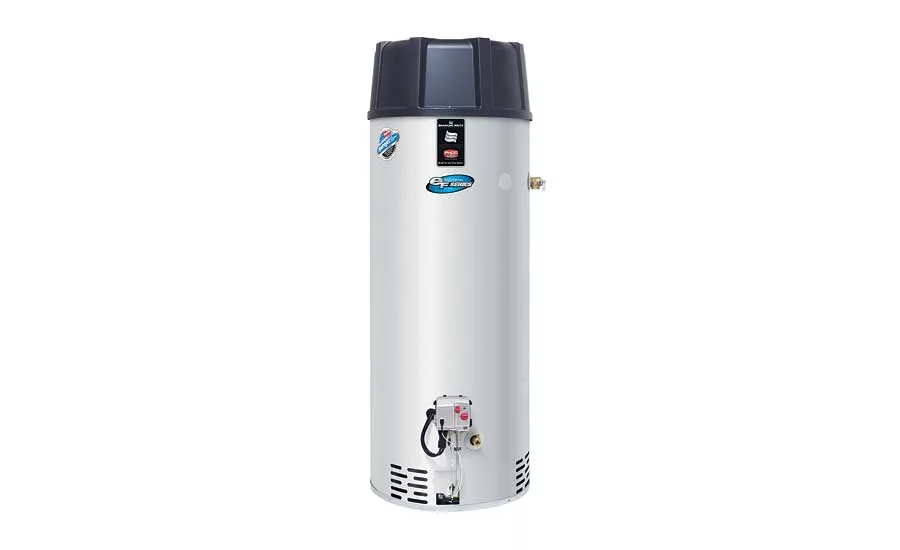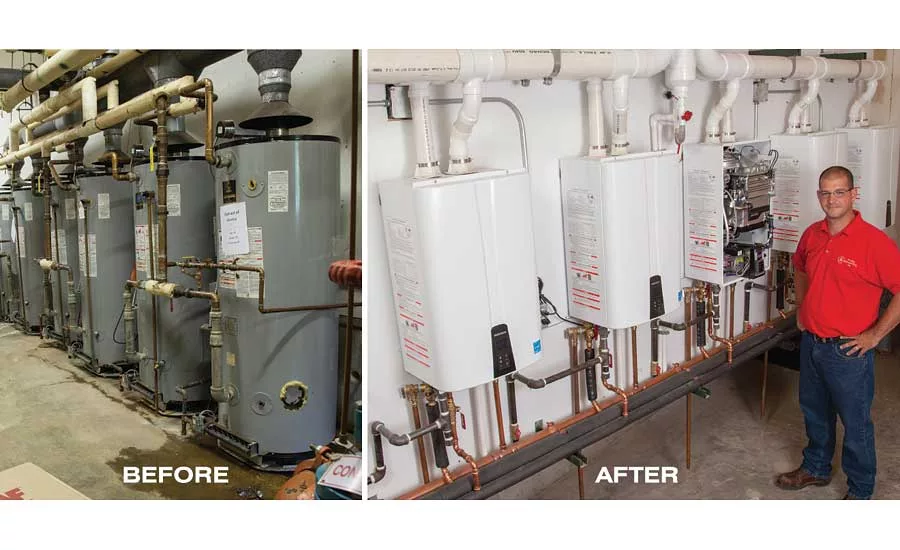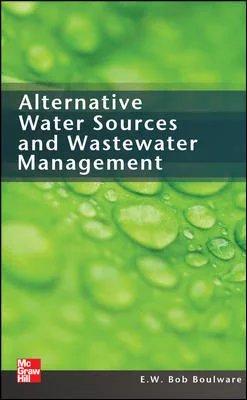Consumer demands shape water heater trends
The water heater conversation.

Bradford White’s high efficiency eF Series residential power vent water heater offers a thermal efficiency over 90% and a high hot water recovery rate. Photo credit: Bradford White

American Standard Water Heaters' Residential Electric Heat Pump Water Heater uses electricity to move heat from one place to another instead of generating heat directly. Photo credit: ASWH

Portland, Oregon-based Mt. Tabor Brewery utilized a new A. O. Smith Commercial Tankless Rack System with three tankless units paired with a storage tank to provide hot water for its brewing process and for cleaning the large stainless steel tanks. Photo credit: A. O. Smith

Jason Richards of A+ Plumbing, Heating, Cooling, Inc. replaced leaking tank water heaters with Navien NPE tankless units as a resort in Indiana. Photo credit: Navien
The April 2015 National Appliance Energy Conservation Act (NAECA) energy requirements for water heaters significantly impacted tank-type and, to a lesser extent, tankless water heaters. And while there have not been as many drastic changes in product lineups since then, manufacturers are still diligently working to further improve their product lines.
The consumer is also doing more research and engaging more in the selection process. Water heating remains one of the top energy expenses in the home, and homeowners and businesses are looking for smart investments that create value by reducing monthly bills. To find those savings, they’re asking for more innovative products.
A shift toward tankless
Information about these products is readily available to motivated end users exploring their hot water options. As the availability of high-efficiency alternative water heating technology continues to spread, these models will continue to receive more consideration from homeowners and contractors.
“The makers of tank-type water heaters had to redesign their systems to meet the standards of efficiency,” said Mark Brickey, wholesale outside sales representative at Metropolitan Industries. “It’s difficult to redesign a tank without making it bigger or adding any additional resources such as power vents or insulation. The direct result is now there’s a concern for space installation. On the other hand, the U.S. tankless market is only roughly 15%, but the numbers are growing because of the efficiency and space-saving benefits.”
The NAECA regulations have driven a trend growth in the tankless market, agreed Brian Fenske, specialty channel sales manager for Navien.
“The NAECA water heater efficiency changes have affected tank water heaters the most,” he said. “With reduced models offered, physically larger tanks, and added cost of units, tankless water heaters have become more attractive. It’s always been the contractor that needs to be comfortable and informed of products available and their best applications. This is gained by training and attending contractor trade shows to learn.”
On the matter of cost, there are two sides, as well.
“It has simply costs everyone a lot of money,” Brickey said. “However, the turnaround situation is that there are rebates that come from the energy companies for going more efficient. Homeowners can reap the most benefits from this because it will put money back in their pockets over time.”
Residential and commercial trends
The growth of new products that have come out over the past few years is not only about efficiency in tankless versus tank-type water heaters — it is also about commercial versus residential trends.
“The trends impact both commercial and residential,” Brickey said. “When Metropolitan Industries entered the business, it was about 95% residential. Now it’s more 60% commercial, 40% residential. The drivers behind these trends in tankless water heaters are the efficiency and space-saving factors. It is also the concerns for flooding because it is mounted on the wall versus on the floor with the water heater tanks. For commercial, the number of places that have wanted tankless water heaters spans from coffee shops, cafés, laundromats, and other industries where their water intake fluctuates on a day-to-day basis.”
Saving space is important to owners, engineers, and architects, Fenske agreed.
“We have seen a trend of understanding, acceptance, and use of multiple tankless water heaters by all three in the commercial space,” he said. “Properly sized and selected, tankless offers the peak gpm required and savings desired for high volume water users. In the residential space, endless and consistent hot water temperature has understandably become the priority of end users when seeking a tankless water heater application — while energy and space savings follow a close third and fourth in reasons for wanting to go tankless.”
Changes you can see
Appearances have also changed — especially in the consideration of residential units. These changes were not just an effect of the regulations, but also a result of the changes in technology.
High-efficiency, condensing, tankless water heaters have reduced stack temperatures so that they can now vent through PVC pipe. “These systems have become increasingly popular,” said Chad Sanborn, product marketing manager at Bradford White Water Heaters. “Also, the addition of internal bypass valves has increased temperature stability of many tankless water heaters, making large temperature fluctuations a thing of the past.”
A water heater can now have Bluetooth and internet connectivity and interact with smartphones, allowing homeowners more control and contractors easier diagnostic capabilities. Some also allow for touchscreen operation.
“Internet connectivity has become a significant technological trend in tank products because, more and more, homeowners and facility managers want additional control over their hot water — and real-time monitoring,” said David Chisolm, vice president of marketing at A. O. Smith. “More tank water heaters are now changing to accommodate electronic controls with more internet-ready interfaces as manufacturers have put an increased focus on the user experience.”
Location also has an impacted the aesthetic of water heaters.
“Tankless cabinet looks have become more attractive, allowing their location to be placed in visible spaces,” Fenske said. “Fronts are sleeker looking and often incorporate advanced control panels.”
American Standard Water Heaters models have witnessed their most significant change in appearance most recently in July 2016 with the introduction of its four-year warranty for all commercial models.
“We changed the exterior of the commercial water heaters from an all-brown exterior to dramatic black and platinum exterior, making models that carry the protection of the warranty immediately identifiable,” said Eugenio Garza, marketing director at American Standard Water Heaters. “We also introduced residential tankless condensing water heaters this year as opposed to non-condensing simply because of efficiency.”
Non-condensing tankless water heaters efficiencies are approximately 80% AFUE. The heating process creates highly corrosive condensation and requires special non-corrosive venting materials to withstand the intense heat that is not used and wastes energy that could otherwise be used to heat the water.
Conversely, tankless water heaters extract the additional heat from exhaust gases by various means and exhaust far cooler gases. These don’t require special venting but are more expensive to manufacture. They achieve efficiency ratings of up to 98%, depending on the geographical location. It was due to this higher efficiency rating that manufacturers made the decision to provide residential tankless condensing water heaters.
Also introduced have been residential electric heat pump water heaters. These use electricity to move heat from one place to another instead of generating heat directly and are up to three times more energy efficient than conventional electric resistance water heaters.
“American Standard Water Heaters residential electric heat pump water heaters are complete stand-alone heat pump water heating systems as integrated units with a built-in water storage tank and back-up resistance heating elements,” Garza said. “Highly efficient, the heat pump water heaters are great for the environment and savings are quickly realized in as little as two years or less.”
A. O. Smith has seen similar trends. In commercial applications, the top priority for hot water systems is high efficiency. In recent years, facility managers have seen energy efficient hot water systems produce a fast payback in high-use applications. For residential hot water systems, high-efficiency alternate technologies — tankless, heat pump and condensing products — will continue to gain traction with homeowners and residential contractors. Proactive homeowners are naturally interested in products at the forefront of technological innovation.
“For tank water heaters, new technological advancements have centered on energy efficiency, such as our hybrid electric heat pump and our full line of condensing gas products,” Chisolm said. “With tankless products, condensing technology has come a long way in the last five years, which has produced tremendous energy efficiency for customers.
“Another advancement in tankless technology is the integration of internal recirculating systems, which add meaningful value for end users. Also available are pre-fabricated rack systems that allow commercial facilities managers to harness the power of multiple tankless models by pairing them together. It is simple technology, but we’re definitely seeing a growing interest because of the ease of installation, energy efficiency, and reduced maintenance.”
Growth and progress
Hot water systems are evolving hand-in-hand with 21st century industrial, commercial, and residential projects. Manufacturers are expanding product offerings and investing in new technologies to meet the broadening demands of the market and specialized application needs.
“A one-size-fits-all approach is outdated in today’s marketplace, where businesses have wide-ranging hot water needs and an increased appetite for savings,” Chisolm said. “In our case, we have invested heavily to advance new technologies in our products and improve existing technology to meet the market’s demand for energy efficient solutions across a variety of specialized applications.”
These changes have affected manufacturers, industry professionals, and consumers.
“Manufacturers have seen increased production costs, assembly line modifications, and advances in engineering,” Sanborn said. “Consumers will gain greater operating efficiencies and the connective features they want, but commensurate increases in cost are likely to occur.”
But most importantly, industry changes magnify the importance of professional contractors. As products have become more complex and more specialized, manufactures have seen an increased demand for specialized training. There are more hot water products available than ever before, which increases the amount of research contractors and end users must do to find the product that works best for their needs.
“Proper installation and maintenance continue to be the key factors for ensuring product performance and customer satisfaction,” Chisolm said. “That’s why we created A. O. Smith University, an on-demand, online learning experience that provides training contractors can use in the field. It is also why we are working to take out some of the guess work with online tools like our Xpert residential water heater selector, which provides users tailored recommendations based on their or their client’s needs.”
As Chisolm said, the days of the one-size-fits-all mentality seem to be waning. Customers want options, and they want to know that they are getting value, so contractors who become well-versed in the range of technologies that are available and can provide guidance on when certain products should — or shouldn’t — be recommended will have an advantage in this market sector. And, contractors who initiate conversations that focus on total cost of ownership instead of only quoting up-front costs will be more successful, especially when they also educate customers about available financing as well as local and state incentives for installing these efficient water-heating technologies.
This article was originally titled “The water heater conversation” in the January 2017 print edition of Plumbing & Mechanical.
Looking for a reprint of this article?
From high-res PDFs to custom plaques, order your copy today!






